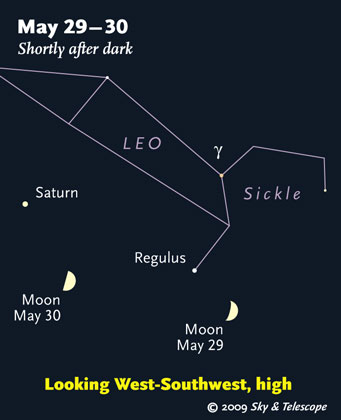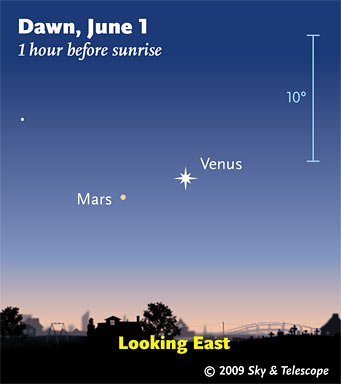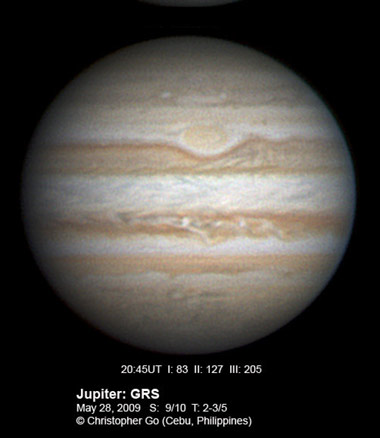Some daily events in the changing sky for May 29 – June 6.

Once a month, the Moon poses with Regulus and Saturn on successive nights. (These scenes are drawn for the middle of North America. European observers: move each Moon symbol a quarter of the way toward the one for the previous date.)
Sky & Telescope diagram
Friday, May 29
- The Moon shines about 5° lower right of Regulus this evening (for North America), as shown here.
Saturday, May 30
- The first-quarter Moon tonight is about 8° lower right of Saturn, as shown here.
Sunday, May 31
- A globular cluster looks in binoculars like a dim, slightly fuzzy star. The globular M3 in Bootes offers a fine chance to make this comparison; it's just ½° from a star of the same brightness (6th magnitude). Find them starting from Arcturus, using the chart in Gary Seronik's "Binocular Highlight" in the June Sky & Telescope, page 45.
Monday, June 1
- After dark, the head of Scorpius is already looming well up in the southeast. In the depths above it smoulders the 18th-magnitude recurrent nova U Scorpii. Bradley Schaefer predicts that U Sco is likely to erupt again (to 8th or 9th magnitude) sometime this year. To catch it during its 5-hour rise, a lot of telescope users will have to be checking it often. Want to join them? See our article. Observers are especially needed around the world at longitudes that are sparsely populated with astronomers.

All week, faint little Mars remains 5° to the left or lower left of dazzling Venus before dawn. The blue 10° scale is about the size of your fist held at arm's length.
Sky & Telescope diagram
Tuesday, June 2
- Look for Spica to the Moon's upper left this evening. Much higher above them shines brighter Arcturus. The Moon is 1.3 light-seconds from Earth, Arcturus is 37 light-years, and Spica is 260 light-years away.
Wednesday, June 3
- This evening, Spica shines to the Moon's upper right.
- A small telescope will almost always show Titan, Saturn's largest moon. Tonight Titan is four ring-lengths to Saturn's west. A guide to identifying other Saturnian satellites often visible in amateur scopes is in the June Sky & Telescope, page 47.
Thursday, June 4
- Face northwest after dark and look very high for the Big Dipper, hanging down by its handle. Can you see little Alcor right next to Mizar, the handle's middle star? A line from Mizar through Alcor always points toward Vega.
Friday, June 5
- Vega is the brightest star shining in the east after dark. Deneb is the brightest to its lower left (by two or three fist-widths at arm's length). Look for Altair farther down to Vega's lower right. These three stars form the huge Summer Triangle.
Saturday, June 6
- The Moon occults (covers) 1st-magnitude Antares tonight for much of North America and for all of Mexico, Central America, northern South America, and the Caribbean. See the article and maps in the June Sky & Telescope, page 52.
Want to become a better amateur astronomer? Learn your way around the constellations. They're the key to locating everything fainter and deeper to hunt with binoculars or a telescope. For an easy-to-use constellation guide covering the whole evening sky, use the big monthly map in each issue of Sky & Telescope, the essential magazine of astronomy. Or download our free Getting Started in Astronomy booklet (which only has bimonthly maps).
Sky Atlas 2000.0 (the color Deluxe Edition is shown here) plots 81,312 stars to magnitude 8.5. That includes most of the stars that you can see in a good finderscope, and typically one or two stars that will fall within a 50× telescope's field of view wherever you point. About 2,700 deep-sky objects to hunt are plotted among the stars.
Alan MacRobert
Once you get a telescope, to put it to good use you'll need a detailed, large-scale sky atlas (set of charts; the standards are Sky Atlas 2000.0 or the smaller Pocket Sky Atlas) and good deep-sky guidebooks (such as Sky Atlas 2000.0 Companion by Strong and Sinnott, the more detailed and descriptive Night Sky Observer's Guide by Kepple and Sanner, or the classic Burnham's Celestial Handbook). Read how to use them effectively.
Can a computerized telescope take their place? I don't think so — not for beginners, anyway, and especially not on mounts that are less than top-quality mechanically. As Terence Dickinson and Alan Dyer say in their Backyard Astronomer's Guide, "A full appreciation of the universe cannot come without developing the skills to find things in the sky and understanding how the sky works. This knowledge comes only by spending time under the stars with star maps in hand and a curious mind." Without these, they note, "the sky never becomes a friendly place."
More beginners' tips: "How to Start Right in Astronomy".
This Week's Planet Roundup

Jupiter's Great Red Spot (GRS) was approaching the central meridian when Christopher Go took this image on May 28, 2009. "The GRS is very pale!" writes Go. Also, "There is a very complex rift system at the North Equatorial Belt [just below center]. Note the streaks on the North Temperate Belt. There are large ovals around the area of the North North Temperate Belt." South is up.
For all of the Red Spot's central-meridian crossing times, good worldwide, use our Red Spot calculator or print out our list for 2009.
Mercury is hidden deep in the glow of sunrise.
Venus (magnitude –4.5, near the Pisces-Aries border) shines brightly due east during dawn, moderately low. Don't confuse it with Jupiter, much higher and far to the right in the southeast.
In a telescope Venus appears about half lit; it's at western elongation from the Sun on June 5th (46° from the Sun), but it will probably appear half lit (at dichotomy) several days after. How accurately can you judge this date in the eyepiece? The best telescopic views of Venus come in full early-morning daylight, when Venus is higher in steadier air.
Mars (magnitude +1.2, near the Pisces-Aries border) remains about 5° to Venus's lower left in early dawn all week. But it's about 200 times fainter! There are four reasons for this: Mars is a smaller planet than Venus, it's farther from the Sun so it gets illuminated less brightly, its surface is darker than Venus's white clouds, and it's currently farther from Earth.
Jupiter (magnitude –2.5, in Capricornus) shines brightly in the southeast before and during dawn, high enough now for good telescopic observing. The sharpest glimpses may come during morning twilight, when the atmospheric seeing sometimes turns very steady.

These four images by Sean Walker show Saturn's rings dimming and closing from 2006 to 2009. North is up. The rings are now so dim because they're currently more nearly edge-on to the Sun than they are to Earth.
S&T: Sean Walker
Saturn (magnitude +0.9, in Leo) is now high in the southwest at nightfall. It moves lower toward the west later in the night. Regulus, not quite as bright, sparkles 15° to Saturn's lower right.
In a telescope Saturn's rings still appear 4° from edge on, their widest this year. But see how the once-bright rings have dimmed! The caption at right tells why.
Uranus (magnitude 5.9, in Pisces) is midway between Venus and Jupiter before dawn.
Neptune (magnitude 7.9, in Capricornus) still appears only about ½° from Jupiter, though it's 15,000 times dimmer. See our finder charts for Uranus and Neptune.
Pluto (14th magnitude, in northwestern Sagittarius) is highest in the south in the early-morning hours.
All descriptions that relate to your horizon or zenith — including the words up, down, right, and left — are written for the world's mid-northern latitudes. Descriptions that also depend on longitude (mainly Moon positions) are for North America. Eastern Daylight Time (EDT) equals Universal Time (also known as UT, UTC, or GMT) minus 4 hours.
To be sure to get the current Sky at a Glance, bookmark this URL:
http://SkyandTelescope.com/observing/ataglance?1=1
If pictures fail to load, refresh the page. If they still fail to load, change the 1 at the end of the URL to any other character and try again.
 0
0
Comments
You must be logged in to post a comment.